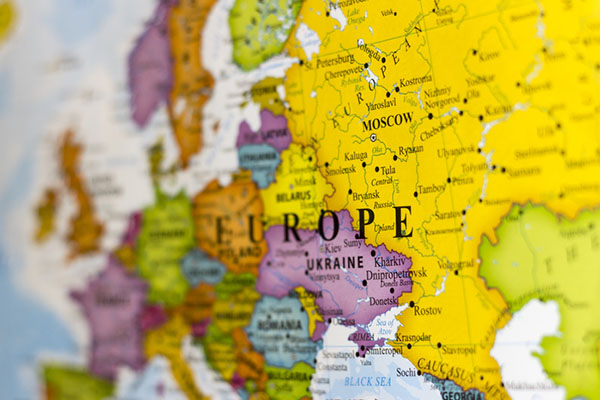Editor’s Note:
 Dana Bodnar is an economist at Atradius, responsible for macroeconomic and country risk analysis specializing in Central and Eastern Europe. She joined Atradius in 2014 after completing her master's degree in International Economics at Utrecht University in the Netherlands.
Dana Bodnar is an economist at Atradius, responsible for macroeconomic and country risk analysis specializing in Central and Eastern Europe. She joined Atradius in 2014 after completing her master's degree in International Economics at Utrecht University in the Netherlands.
 Arkadiusz Taraszkiewicz is a senior manager of Central and Eastern European risk services at Atradius Credit Insurance. He earned his executive MBA from the European University in Montreux, Switzerland. He has been working in financial institutions for more than two decades and has been with Atradius since 2001.
Arkadiusz Taraszkiewicz is a senior manager of Central and Eastern European risk services at Atradius Credit Insurance. He earned his executive MBA from the European University in Montreux, Switzerland. He has been working in financial institutions for more than two decades and has been with Atradius since 2001.
GDP growth is expected to dip across the board in 2019, and Eastern Europe is not immune from this cloudy outlook. For businesses trading within the region, this isn't so much cause for distress as it is a call to keep a close watch on emerging risks. Here, as in elsewhere on the globe, the main threats to growth ahead are geopolitical uncertainty and policy missteps.
The less rosy outlook follows a year of respectable growth, reaching 3 percent due to tightening labor markets, low borrowing costs, wage growth and a number of other factors. And although growth in Eastern Europe may slow in the near future, it remains a favorable business climate, with high domestic demand and easy access to the major supply chains of Western European markets.
Uncertainty Breeds Insecurity
Uncertainty is on the rise, and that spells trouble for economic growth as it discourages firms and households from spending and dampens investments. The U.S.-China trade war and the increasingly complicated Brexit deal are two major sources of uncertainty that could make waves far beyond their immediate scope.
In Eastern Europe, continued sanctions against Russia contribute a massive dose of geopolitical uncertainty to the region. Atradius analysts predict modest growth of around 1.5 percent in 2019, a slight decrease from the 1.9 percent growth experienced in 2018.
While growth in Russia is currently helped by rising oil prices, low inflation and improved consumer and business confidence, the high (and likely getting higher) tension between Russia and the West constitutes a major threat. If the U.S. administration makes good on its threats to withdraw from the nuclear arms treaty, security risks would rise. Actual military conflict is unlikely, but the threat itself is enough to sink confidence and cause negative long-term economic effects.
For American businesses trading with Russian firms, sanctions are the biggest area of concern, as they threaten the stabilizing Russian economy. These were first imposed upon Russia following the country's interference in Crimea in 2014, with additional sanctions following Russia's meddling in the 2016 U.S. presidential election and after the alleged attack on a former Russian spy and his daughter. These moves have exerted considerable downward pressure on the ruble, which has weakened about 5 percent against the dollar since May 2018. Analysts say additional sanctions are likely in 2019.
A High Price for Policy Mistakes
Careful policymaking is essential if Eastern European countries hope to maintain the positive business environment through 2019. The stakes are especially high at the moment: In order to converge to the EU, Eastern Europe needs ongoing investment to maintain infrastructure and competitiveness through productivity. The EU threatens to withhold structural funding for countries with unacceptable opinions on democracy, the rule of law and immigration.
Already, populist governments in Hungary and Poland have heated up political and social tensions, caused institutional deterioration and even attracted international condemnation. Needless to say, this threatens long-term growth. In late 2018 in response to the Hungarian government's attempts to silence media, remove independent judges and target NGOs, the EU imposed Article 7. This opens the door for potential sanctions designed to deter anti-democratic policies. Poland faces similar sanctions for a new law that reduces the retirement age of Supreme Court judges from 70 to 65, which the EU considers a threat to the independence of the judiciary. Analysts say similar scenarios could play out in Eastern Europe throughout 2019, which may harm investor interest in the region.
Turkey is another dark spot on Eastern Europe's outlook for 2019. Arguably the least stable country in the region, Turkey's economy has been struggling mightily since the second half of 2018, thanks to policy mistakes and slow government response to inflation. GDP growth was 7.4 percent in 2017, down to 3.9 percent in 2018 and will likely plummet to 1.8 percent in 2019. What's more, the Turkish lira is down 30 percent compared to last year, while inflation is high and interest rates are soaring at 24 percent. Turkey's corporate sector is feeling the squeeze, with productivity decreasing and insolvencies likely to hit 15 percent in 2019.
Thus far, Turkey's attempts to correct the economy have been questionable. Recent interventions have included curtailing the use of foreign currency in domestic transactions and requiring exports to convert a large share of their foreign currency back to lira. Analysts say a recession is a possibility.
Opportunities Remain
Although risks are on the rise in Eastern Europe, the same can be said for many other regions in the world, and the environment is still strongly pro-business in many countries and will likely remain so for some time. The Czech Republic, for instance, looks to be stable and resilient for 2019, with policymaking remaining pro-business and pro-EU, despite some recent populist rhetoric.
Risks are unavoidable in conducting business, whether keeping it close to home or brokering deals abroad. Businesses can mitigate those risks, however, by keeping informed of developing geopolitical scenarios, as well as the economic and political health of individual countries. Trade credit insurance is one useful tool, as it not only protects accounts receivable against delayed or missing payments, but trade credit insurers also provide regular analysis and reporting on countries, industries and even individual firms all over the globe.
SC
MR


Latest Supply Chain News
- How CPG brands can deliver on supplier diversity promises
- How S&OP provides the answer to in-demand products
- AI, virtual reality is bringing experiential learning into the modern age
- Humanoid robots’ place in an intralogistics smart robot strategy
- Tips for CIOs to overcome technology talent acquisition troubles
- More News
Latest Podcast

 Explore
Explore
Business Management News
- How CPG brands can deliver on supplier diversity promises
- How S&OP provides the answer to in-demand products
- AI, virtual reality is bringing experiential learning into the modern age
- Tips for CIOs to overcome technology talent acquisition troubles
- There is still work to do to achieve supply chain stability
- Blooming success: The vital role of S&OE in nurturing global supply chains
- More Business Management
Latest Business Management Resources

Subscribe

Supply Chain Management Review delivers the best industry content.

Editors’ Picks





